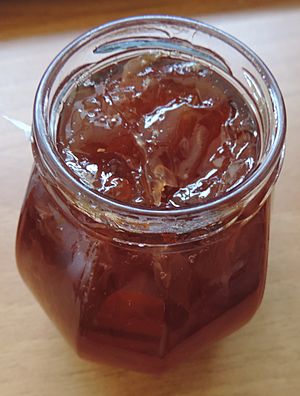Jam facts for kids

Jam refers to a product made of whole fruit cut into pieces or crushed, then heated with water and sugar until it reaches "jelling" or "setting" point, which is achieved through the action of natural or added pectin. It is then sealed in containers.
Jam making became "a great new industry" in 19th century England, at which point English jam makers were jam makers for the world, thriving after the repeal of sugar duties in 1874.
Pectin is mainly D-galacturonic acid connected by α (1–4) glycosidic linkages. The side chains of pectin may contain small amounts of other sugars such as L-fructose, D-glucose, D-mannose, and D-xylose. In jams, pectin thickens the final product via cross-linking of the large polymer chains.
Recipes without added pectin use the natural pectin in the fruit to set. Tart apples, sour blackberries, cranberries, currants, gooseberries, Concord grapes, soft plums, and quinces work well in recipes without added pectin. For raspberry jam with added pectin, use one box of pectin for 5 cups of fresh raspberries.
Other fruits, such as apricots, blueberries, cherries, peaches, pineapple, raspberries, rhubarb, and strawberries are low in pectin. In order to set, or gel, they must be combined with one of the higher pectin fruits or used with commercially produced or homemade pectin. Use of added pectin decreases cooking time.
Freezer jam is uncooked (or cooked less than 5 minutes), then stored frozen. It is popular in parts of North America for its very fresh taste.


